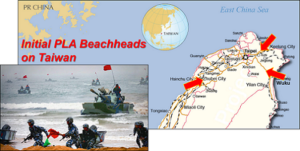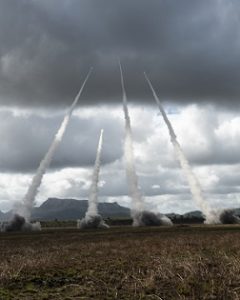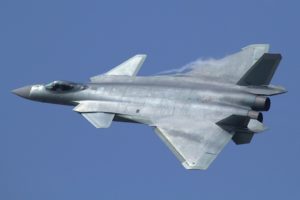[Editor’s Note: In reportedly “blunt and candid” discussions during their summit in San Francisco, California, on 15 November 2023, President Xi Jinping informed President Joe Biden that China intends to reunify Taiwan with the mainland.
Our colleagues at Military Review recently published Three Dates, Three Windows, and All of DOTMLPF-P, by Ian Sullivan, Deputy Chief of Staff, Intelligence (DCSINT), U.S. Army Training and Doctrine Command (TRADOC) G-2, describing the Chinese Communist Party’s (CCP’s) ongoing efforts to transform the People’s Liberation Army (PLA) into a force capable of “challeng[ing] the U.S. Army and joint force across the three areas that have underpinned U.S. military dominance in the post-Desert Storm period: dominance in materiel, dominance in soldiers and leaders, and dominance in approach to warfare.” Its reunification of Taiwan with the Chinese mainland is one objective driving this transformation.
Today’s post by returning blogger Dr. Robert E. Smith continues his exploration of how China could achieve Taiwan’s reunification with the mainland through innovative and disparate kinetic and liminal means, in collaboration with our adversaries around the globe. Dr. Smith delves into a compelling rationale behind the CCP’s pursuit of this course of action — Taiwan’s dominance of the semiconductor industry — and two liminal attack vectors — submarine cables and weather manipulation / “natural” disaster generation — that could be exploited to help achieve this possibility. Enjoy!]
Prelude
Specter of a Cross-Strait Conflict
China’s goals for reunification with Taiwan faces substantial hurdles. The intricacies of orchestrating an amphibious invasion through the Taiwan Strait presents formidable challenges such as limited permissive landing locations, traversing mountainous terrain, and finally fighting in a dense urban environment. Taiwan boasts a 163,000-strong active military force and an impressive 1.6 million reserves. Taiwan has adopted a “porcupine” strategy, prioritizing survivability through underground airfields and fortified infrastructure not unlike China’s Underground Great Wall. Beijing’s calculations are further complicated by the imposing US Pacific presence, which includes 66 military bases, 86,000 Marines, 106,000 Soldiers, and an extensive arsenal of strategic assets primed for defense.
 Wargames conducted by CSIS in 2023 offer perspective on the feasibility of a Chinese takeover of Taiwan. Among the 24 simulated amphibious invasions, the majority predicted a U.S./Taiwan/Japan victory, albeit with significant costs. The initial phases of these mock invasions often witness a depleted Taiwanese Navy and Air Force. Nevertheless, unwavering support from the United States and Japan consistently thwarts China’s ambitions, safeguarding Taiwan’s autonomy. China’s geographic proximity provides an advantage (interior lines), enabling the swift deployment of its 2,035,000 active personnel. However, the sheer scale of such an invasion, involving anywhere from 400,000 to over two million troops, could provoke global condemnation.
Wargames conducted by CSIS in 2023 offer perspective on the feasibility of a Chinese takeover of Taiwan. Among the 24 simulated amphibious invasions, the majority predicted a U.S./Taiwan/Japan victory, albeit with significant costs. The initial phases of these mock invasions often witness a depleted Taiwanese Navy and Air Force. Nevertheless, unwavering support from the United States and Japan consistently thwarts China’s ambitions, safeguarding Taiwan’s autonomy. China’s geographic proximity provides an advantage (interior lines), enabling the swift deployment of its 2,035,000 active personnel. However, the sheer scale of such an invasion, involving anywhere from 400,000 to over two million troops, could provoke global condemnation.

To counter China’s numerical superiority, the U.S. is actively pursuing innovations like Replicator, proposed by Deputy Secretary of Defense Kathleen Hicks, which aims to deploy swarms of cost-effective drones within 18-24 months, leveling the playing field and enabling rapid target acquisition and engagement in the Indo-Pacific region. Replicator builds on lessons from Ukraine’s highly effective drone targeting and strikes from unmanned aerial systems on Russia, as well as success in the Black Sea fleet with missiles and explosive-laden unmanned vessels. Replicator addresses the main challenge the United States military would face in the Pacific in a fight with China: too many targets across a massive geographic space. How many targets does that mean? “Here’s a metric for me: 1,000 targets for 24 hours,” said Adm. John Aquilino, head of U.S. Indo-Pacific Command (Note: A great reference on conventional options for an invasion are presented in this article: T-Day: The Battle for Taiwan).
Autocratic Alignment
The convergence of autocratic powers, comprising Russia, China, North Korea, and Iran, is forcing the United States into a strategic conundrum of choices. Each of these nations presents distinct defense challenges, rendering the determination of spending requirements a perplexing task. At the heart of this emerging axis lies a web of interwoven technical and economic interests: Russia’s dire munitions shortage; China’s unrelenting quest for energy resources; and the shared nuclear ambitions of North Korea and Iran. Russia, grappling with critical weapon deficits due to the ongoing Ukrainian conflict, sees North Korea’s abundant munitions as a viable solution. China and Russia have conducted Joint naval exercises in the Pacific and Russia has proposed incorporating North Korea into these. In March 2023, Iran, China, Russia and others conducted Joint naval drills in the Gulf of Oman during Security Bond-2023 exercises.
China’s contribution to imposing autocratic multiple dilemmas is in convincing the U.S. that that an amphibious invasion is imminent. Nancy Pelosi’s 2022 visit to Taiwan gave the PRC the perfect excuse to ramp up signaling. Pelosi’s visit sparked a simulated a naval blockade of Taiwan which has become the PLA standard response to major visits, like the 2023 visit of President Tsai to the U.S. China has even gone as far as practicing deploying assault craft from commercial ferries. However, an amphibious invasion, for reasons outlined above, is the least likely method for China to achieve reunification with Taiwan – but it’s an ideal method to trigger misguided U.S. defense spending on exotic conventional-fight platforms in the Pacific.

China has completely normalized median crossings in the strait: 564 PLA aircraft were tracked crossing the median line in 2022, which is more than 24 times the total of known median line crossings prior to the Pelosi visit. This erodes reliable indicators and warnings. Additionally, Chinese illegal fishing activities and PRC Coast Guard harassment in established maritime borders (economic exclusion zones) are attempting to redraw borders to the PRC nine-dash line. Simultaneously, Kim Jong Un continues to harass with ICBM launches and nuclear weapon developments – which are the responsibility of a distracted INDOPACOM.
China Taiwan: The World’s Silicon Beacon
Globally, Taiwan’s dominance of the semiconductor industry is unparalleled. Major tech brands, such as Nvidia, depend heavily on Taiwan Semiconductor Manufacturing Company (TSMC) production capabilities. When juxtaposed with the facts that China’s imports 94% of semiconductors and TSMC fills 70% of this deficit, the significance of Taiwan’s position becomes clear. The semiconductor sector is one place where China is still 10-15 years behind the ![]() United States because hard-to-steal specialized equipment, design software, and human capital all are part of the production recipe. In 2021, the CHIPS Act was introduced in the U.S. Congress to further assure China can’t just steal its way into semiconductors. China claims to have developed seven-nanometer computer chips for Huawei’s new phone, which would put them only five years behind the United States. Analysts are skeptical that China is actually capable of producing the seven-nanometer chips in mass. Currently, there is a demand surge is driven by growing interest in artificial intelligence and ChatGPT, which relies on advanced GPUs like those from Nvidia.
United States because hard-to-steal specialized equipment, design software, and human capital all are part of the production recipe. In 2021, the CHIPS Act was introduced in the U.S. Congress to further assure China can’t just steal its way into semiconductors. China claims to have developed seven-nanometer computer chips for Huawei’s new phone, which would put them only five years behind the United States. Analysts are skeptical that China is actually capable of producing the seven-nanometer chips in mass. Currently, there is a demand surge is driven by growing interest in artificial intelligence and ChatGPT, which relies on advanced GPUs like those from Nvidia.
Due to this surge, there are concerns that there may be a world shortage of GPU chips. Four major Chinese tech firms have ordered $5 billion worth of Nvidia’s GPUs amid fears of U.S. export restrictions. Nvidia GPUs are already in such short supply that venture capitalists have started buying them directly for their portfolio companies. Even Elon Musk has been buying thousands for his AI ventures including Twitter (now X), Tesla, and his xAI project. In response to the CHIPS Act, China has imposed export controls on Gallium and Germanium, vital raw materials for semiconductors, starting August 1, 2023. An attack on Taiwan could have devastating global economic consequences. Some argue that Taiwan’s dominance in semiconductor production deters an attack, while others contend that China’s desire for unification with Taiwan outweighs economic considerations.
A 2021 Parameters article entitled “Broken Nest: Deterring China from Invading Taiwan” proposes Taiwan destroying its own semiconductor industry in the event of a Chinese invasion, making it a less attractive target. The debate continues on whether Taiwan’s semiconductor dominance affects the likelihood of a Chinese invasion, but the global economic impact of such an attack would be severe. The “China Times” published a commentary in response to Broken Nest, pointing out that the threat of destroying TSMC to prevent the mainland from attacking Taiwan is “the ultimate ignorance. The mainland’s pursuit of cross-strait reunification is definitely not for TSMC’s production capacity.” This ignores the premise of Broken Nest — that China must “believe conquering Taiwan cannot be done without jeopardizing other core interests.” Even without invoking Broken Nest, a cross-strait invasion would starve the world of chips and cause worldwide economic devastation.
Submarine Fibers: Clouds of Gold
 Most people are unaware of wealth creation that rides on submarine fiber optic cables as they are the backbone of cloud infrastructure and the modern digital economy. Subsea fiber cables $22.4 trillion transactions daily. Current market analysis projects the Submarine Optical Fiber Cable sector to balloon from $3.63 billion in 2023 to $6.42 billion by 2028. Advanced AI systems, including models like ChatGPT, owe their rapid evolution to these technologies which combine multiple data center storage and computing capabilities to train large models.
Most people are unaware of wealth creation that rides on submarine fiber optic cables as they are the backbone of cloud infrastructure and the modern digital economy. Subsea fiber cables $22.4 trillion transactions daily. Current market analysis projects the Submarine Optical Fiber Cable sector to balloon from $3.63 billion in 2023 to $6.42 billion by 2028. Advanced AI systems, including models like ChatGPT, owe their rapid evolution to these technologies which combine multiple data center storage and computing capabilities to train large models.
There is also a relatively unknown growing submarine “cable war” between the U.S. and China. The U.S. government is intervening in undersea cable deals to prevent Chinese companies from acquiring strategic contracts due to espionage concerns. Team Telecom, an interagency committee safeguarding U.S. telecommunication networks, played a pivotal role in shaping cable licensing recommendations and ensuring no direct connections between U.S. territories and China or Hong Kong. Conversely, China has also hindered cable projects in which American firms like Meta are involved, complicating the undersea cable landscape. Taiwan, is a critical hub of SE Asia fiber connectivity with multiple subsea fibers, recognized the importance of securing its internet infrastructure beyond its extensive undersea cables.
Ukraine’s experience during the ongoing Russian invasion has demonstrated the importance of having a resilient communication infrastructure. DoD communications in the Pacific ride primarily on 529 commercial undersea telecommunication cables and 1,444 landings which are extremely vulnerable. These privately owned cables carry about 99% of transoceanic digital communications (i.e., voice, data, internet). The DoD primarily relies on these commercial subsea fibers to pass data as there is no other technical solution that provides even close to the same data bandwidth and low latency across the planet. Subsea fiber optic cables are regularly broken and/or damaged by anchors, trawling nets, and even seismic activity. Hostile actors can easily cloak hostile actions behind accidental fishing or anchoring occurrences. Recently, Chinese fishing vessels were linked to two incidents where undersea cables linking Taiwan and its outlying Matsu Islands were cut: Feb. 2, 2023 was due to a Chinese fishing boat; Feb. 8, 2023 was linked to a cargo ship of Chinese origin. A CNAS wargame published in a paper entitled “More than Half the Battle, Information and Command in a New American Way of War” saw Chinese red teams cut the cables connecting Taiwan to the rest of the world and targeted U.S. cable networks across the western Pacific. They also targeted cable landing stations with missiles which is clearly more escalatory.
To mitigate such risks, Taiwan has embarked on a mission to secure backup internet options. The nation’s Ministry of Digital Affairs allocated approximately $18 million over the next two years to bolster internet resilience. Among the contenders is OneWeb, a UK-based satellite company, expected to provide comprehensive coverage to the entire island by the end of 2023. Taiwan has expressly stated they do not want Starlink due to Elon Musk’s business ties in China. Additionally, discussions with other satellite providers, such as Amazon’s Project Kuiper, were underway, signaling Taiwan’s proactive stance. Providing direct-to-Satellite cell phone services is a fast developing area, including the elimination of the terminals required by Starlink. Apple has modified its phones to allow emergency messaging, but AST and Lynk Global are already able to provide connectivity on existing cell phones with no antenna or radio modifications – they are essentially cell towers in space. Lynk currently has three satellites operational and recently signed Palau as a customer. Starlink, Lynk, OneWeb, and AST are all low earth orbit systems (LEO) and China has invested in a wealth of jamming, tracking, and anti-satellite capabilities such as the SLC18 and even anti-satellite missiles.
Masters of the Elements
 Weather manipulation for strategic gain is becoming prominent, with China’s extensive weather program as a prime exhibit. China aims to modify the weather over an area of 2.1 million square miles – more than 1.5 times the total size of India. Their capability to influence regional weather has profound ramifications, especially for vital waterways like the Mekong River. Military advancements like Russia’s Poseidon torpedo and North Korea’s Haeil drone both induce tsunamis and highlight the increasing militarization of nature. Climate change, already displacing millions, only heightens the significance of such programs. China is hiding its activities by sowing diversion, claiming the recent fires on Maui were caused by a US climate control experiment gone awry.
Weather manipulation for strategic gain is becoming prominent, with China’s extensive weather program as a prime exhibit. China aims to modify the weather over an area of 2.1 million square miles – more than 1.5 times the total size of India. Their capability to influence regional weather has profound ramifications, especially for vital waterways like the Mekong River. Military advancements like Russia’s Poseidon torpedo and North Korea’s Haeil drone both induce tsunamis and highlight the increasing militarization of nature. Climate change, already displacing millions, only heightens the significance of such programs. China is hiding its activities by sowing diversion, claiming the recent fires on Maui were caused by a US climate control experiment gone awry.
While Artificial Intelligence (AI) applications like OpenAI’s ChatGPT-3 can streamline various sectors, their carbon and environmental footprint remain under scrutiny. The growth of AI in recent years, according to a study by Nuha Dolby in the Wall Street Journal, reveals that information and communications technologies contribute to almost 3% of global greenhouse-gas emissions, akin to the emissions from the entire aviation industry. For perspective, the training of machine-learning models, such as OpenAI’s ChatGPT-3, consumes about three times as much power as newer models like Bloom. This consumption equates to the energy needed to power an average American home for 41 years. Moreover, the water consumption is astounding; Google’s large-language model, LaMDA, guzzled a million liters for training, matching the water thirst of other tech giants. In 2022, Microsoft’s AI projects used water equivalent to filling over 2,500 Olympic-sized swimming pools.
Simultaneously, on the other side of the Pacific, Taiwan grapples with water scarcity. Home to giants like TSMC which consumes 99,000 tons of water daily, the island nation faces its second significant drought in less than two years. TSMC’s water usage has surged by 70% between 2015 and 2019, consuming water equivalent to 60 Olympic-sized pools daily. This escalating demand amidst declining reservoir levels, like the Zengwen Reservoir at just 11.35% of its capacity, endangers Taiwan’s chip production, an industry pivotal for global tech supply chains. Furthermore, climate predictions suggest a 10% decline in rainfall during Taiwan’s dry season by 2050. The concurrent rise in AI’s carbon footprint and Taiwan’s looming water crisis underscores the intricate challenges faced by the global tech industry amidst climate change.
If you missed the first half of Dr. Robert E. Smith‘s post, check it out here
… then check out the following related content:
The TRADOC G-2‘s Operational Environment Enterprise public facing page, with a plethora of content about our pacing challenge at the China Landing Zone, including ATP 7-100.3, Chinese Tactics, BiteSize China weekly topics, People’s Liberation Army Ground Forces Quick Reference Guide, and our thirty-plus snapshots captured to date addressing what China is learning about the Operational Environment from Russia’s war against Ukraine (note that a DoD Common Access Card [CAC] is required to access this last link).
Three Dates, Three Windows, and All of DOTMLPF-P, by Ian Sullivan, published by our colleagues at Military Review
The Most Consequential Adversaries and associated podcast, with GEN Charles A. Flynn
Volatility in the Pacific: China, Resilience, and the Human Dimension and associated podcast, with General Robert Brown (USA-Ret.)
How China Fights and associated podcast
China and Russia: Achieving Decision Dominance and Information Advantage, and “No Option is Excluded” — Using Wargaming to Envision a Chinese Assault on Taiwan by Ian Sullivan
Shén fēng: Military Use of Weather Modification Technology, by Rory Fedorochko
Weaponizing Weather: The Global Security Threat of the Future and associated podcast, with proclaimed Mad Scientist Dr. Elizabeth L. Chalecki
China: Building Regional Hegemony and China 2049: The Flight of a Particle Board Dragon, the comprehensive report from which this post was excerpted
Competition and Conflict in the Next Decade
Disrupting the “Chinese Dream” – Eight Insights on how to win the Competition with China
The U.S. Joint Force’s Defeat before Conflict, by CPT Anjanay Kumar
Sub-threshold Maneuver and the Flanking of U.S. National Security, by Dr. Russell Glenn
Global Entanglement and Multi-Reality Warfare and associated podcast, with COL Stefan Banach (USA-Ret.)
Hybrid Threats and Liminal Warfare and associated podcast, with Dr. David Kilcullen
Weaponized Information: What We’ve Learned So Far…, Insights from the Mad Scientist Weaponized Information Series of Virtual Events, and all of this series’ associated content and videos [access via a non-DoD network]
Insights from Ukraine on the Operational Environment and the Changing Character of Warfare
About the Author: Dr. Robert E. Smith is the Army Futures Command International Science Advisor to U.S. Army Pacific Command. Previously he worked in the Ground Vehicles Systems Center doing research centered early synthetic prototyping and extracting tactics from gaming data. His career includes experience at Ford Motor Co., Whirlpool Corp., and General Dynamics Land Systems. He holds a Ph.D. in Mechanical Engineering from Michigan Technological University with a focus on AI and Machine Learning.
Disclaimer: The views expressed in this blog post do not necessarily reflect those of the U.S. Department of Defense, Department of the Army, Army Futures Command (AFC), or Training and Doctrine Command (TRADOC).



